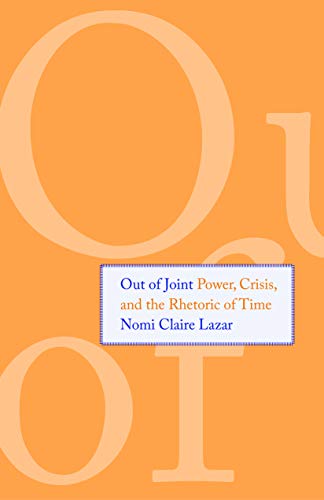Out of Joint. Power, Crisis, and the Rhetoric of Time

Out of Joint. Power, Crisis, and the Rhetoric of Time. Nomi Claire Lazar. New Haven: Yale University Press, 2019.
Lazar explores how political rulers temporally frame historical events to establish their legitimacy, creating a narrative that follows a temporal pattern (“flow of time”). This temporal rhetorical framing supports a leader’s legitimacy in two ways; 1) when it comports with the natural or cosmic cycle of time, e.g., the seasons, rising and setting of the sun and moon, because it feels natural to people; 2) and when it is constructed as a calendar to make the interpretation of past events as a projection of future ones. In several case studies, Lazar examines how the temporal-rhetorical framing provides a range of techniques to legitimize or delegitimize political innovations and address the enduring problems that confront political legitimacy.
Lazar reviews the time technologies that conceptualize and construct time that are not only limited to units of time like days and years but also accounts of progress, historical cycles, and eschatology. Because there is no objective measure of time that would show any given technology is accurate with respect to time itself, time must be understood in terms of its purpose instead of its accuracy. While anchored to some extent in our experience of the natural world, the construction of time organizes events sequentially for a specific purpose with accuracy defined as relative to the requirements of each aim.
In her study of legitimacy, temporal framing is employed to persuade people of a ruler’s legitimacy either by self-justifying orders (tradition, legal and procedural rules, normative arguments as reflected in the order of nature and the cosmos) or from performance capacity which the ruler communicates to the people that he or she is performing well, e.g., the conveying of statistics to show economic progress, military parades to demonstrate national security. To understand a ruler’s legitimacy requires one to understand the deployment of temporal-rhetorical framing within the narrative conveyed.
Lazar explores how calendars are effective tools of rhetorical-temporal framing for rulers. Because they invoke the familiar with a novel intent, the calendar interprets past events in the service of future ones. In her examination of Rome, Maya, and Hungry, Lazar shows how rulers aligned political events or innovation with a cyclically structured narrative that invites people to perceive a ruler’s inevitable imminent glory. To prevent the cyclical problem of political decay, political rulers punctuate the cycle itself by filling the calendar with new festivals and holidays. This linear sense of time, i.e., prospects of future glory, can be inscribed into a calendar, creating a sense of political renewal and legitimacy while simultaneously abide by the cyclical rhythms of the calendar.
Lazar also shows how calendars frame performance capacity in the context of colonizers and imperial powers. The imposition of the imperial power’s calendar upon a subjected people is a way to establish legitimacy of the colonizing power, such as in the cases of Assyria and imperial China. With a sizeable and knowledgeable bureaucracy and sophisticated time technologies, these imperial powers’ calendars make their ruler’s legitimacy seem to be in harmony with cosmic forces and thus mitigate the risk of those who wish to challenge their ruler. The calendar infuses the daily life of the people so the imperial powers’ performance is unquestioned.
But if alignment with order serves legitimation, primitivism – a cluster of views that link increased civilization to declines in wisdom and morality – can expose it as undesirable. When primitivism is used as a temporal-rhetoric frame, it reveals the political order as one of domination, alienation, and constraint rather than security, progress, and freedom. Rousseau’s philosophy is an example of primitivist temporal-framing which claims that our original, natural condition, a condition of peace and freedom, has been corrupted by civilization which has brought us out of this condition. However, as Lazar points out, this “natural state” is ultimately an apolitical one, since the original, natural condition lacks action and choice. Since any order in the primitive condition is natural and self-enforcing, domination does not exist. The result is that time is slow and peaceful, not sequential or regular. Thus, those who adopt the primitive temporal-rhetoric frame is to invoke stalled time, a condition of one of lament, to critique the civilized life as people being subject to a temporal-physical environment that they did not control or choose.
Unlike primitivism, eschatology looks at the end of time and is employed by some to delegitimate the current political order: the only escape from one’s current predicament is to employ violent means to start anew. Eschatology promises inevitability which fuels radical politics. Lazar looks at Voegelin’s analysis of Joachim as a form of eschatological politics but points out that conception of time actually predates the Christian and Western tradition, going back to the Hindu Vedas that reflect eschatological thinking. She next reviews the temporal-rhetorical framing of eschatology of Augustine and Aquinas and post-modern philosophers like Agamben and Zizek. Unlike the Christians, the postmodern left, for Lazar, is at a political dead-end because they rejected both a progressive framework in their narratives and lack a substantial eschatology with its claims of inevitability. As she writes, “Political action demands organization, not spontaneity, self-discipline, not radical freedom” (208).
Out of Joint is a powerful and insightful account of how we understand time in relation to politics and breaks new ground in political theory. It provides scholars a way to reconceptualize political thought and rethink political legitimacy. The book also provides an analytical tool for political forecasting in understanding how societies understand themselves and when they are at vulnerable points of political decay, decline, and revolution. Out of Joint hopefully will be an influential book in political science, setting the stage for new research in political theory and empirical politics.




